PPMP20011 - COMMERCIAL PROJECT NEGOTIATION: Consolidated Portfolio
VerifiedAdded on 2024/06/03
|18
|3943
|106
AI Summary
This consolidated portfolio provides a comprehensive overview of the key learning outcomes covered in the PPMP20011 - Commercial Project Negotiation course. It summarizes the essential concepts and principles related to project negotiation, conflict management, stakeholder engagement, and contract management. The portfolio includes evidence from weekly portfolios, discussions, and real-world examples to illustrate the practical application of these concepts. It also explores the consequences of project delays, disruptions, and changes to planned activities, and examines methods for claims variations, liquidated damages, contract entitlements, and arbitration. Finally, the portfolio evaluates project management tools that help avoid or provide conflict resolution via negotiated solutions.
Contribute Materials
Your contribution can guide someone’s learning journey. Share your
documents today.
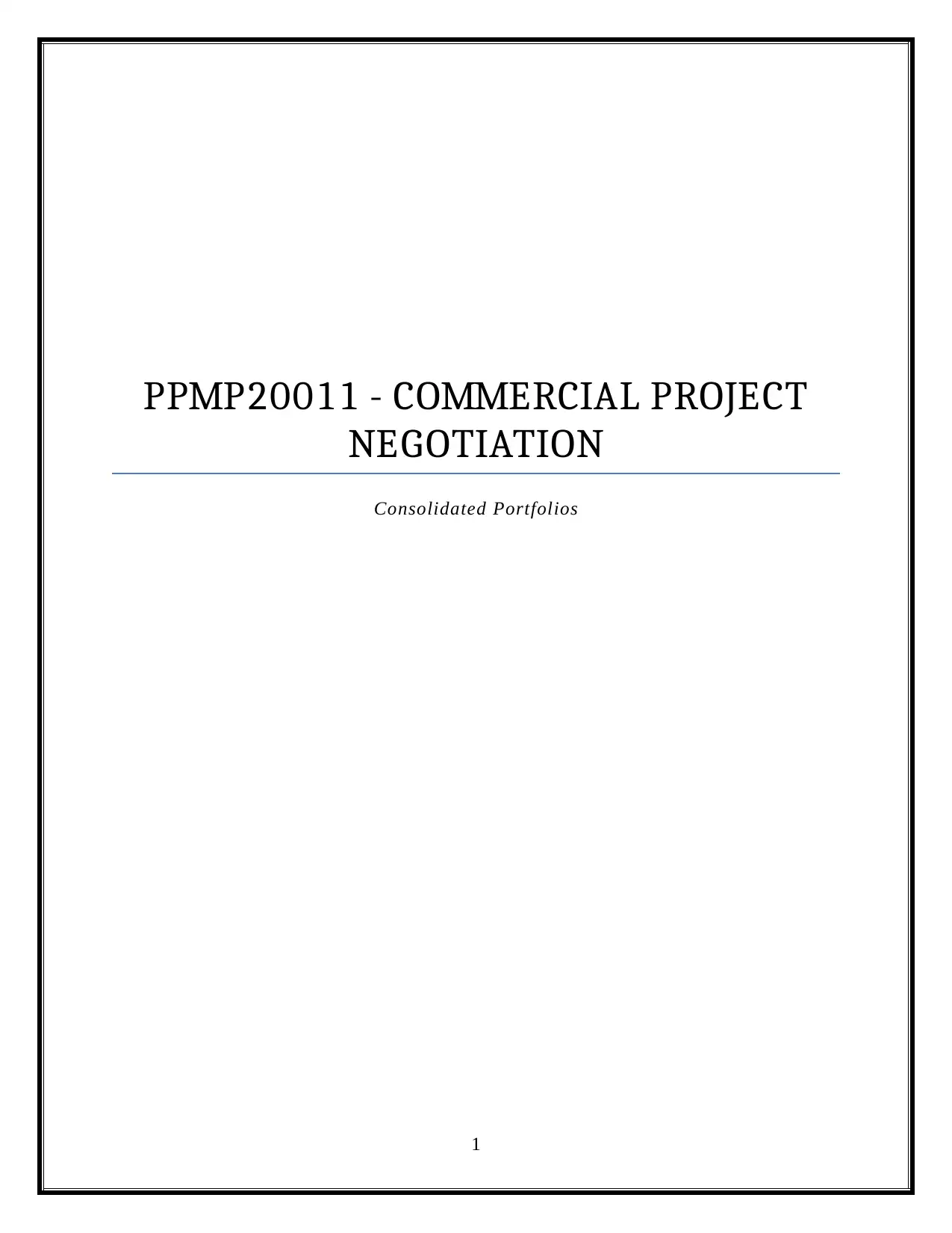
PPMP20011 - COMMERCIAL PROJECT
NEGOTIATION
Consolidated Portfolios
1
NEGOTIATION
Consolidated Portfolios
1
Secure Best Marks with AI Grader
Need help grading? Try our AI Grader for instant feedback on your assignments.

Table of Contents
1. Introduction..................................................................................................................................3
2. Course Learning Outcomes.........................................................................................................4
LO1. Describe the operation of diverse and complex government and non-government project
contractual arrangements relevant to a range of managed services, ICT, and build agreements.
.....................................................................................................................................................4
LO2. Analyse common arguments using logic, persuasion and influence factors as commonly
applied to conflicting and/or competing stakeholder agendas.....................................................5
LO3. Differentiate methods of project negotiation, conflict management, and stakeholder
engagement across projects consisting of differing technology standards and asset lifecycles.. 6
LO4. Explain and apply methods of identifying and reconciling inconsistent and conflicting
objectives and drivers that develop, maintain, manage relationships and communication with
key stakeholders...........................................................................................................................8
LO5. Explain the consequences of project delays, disruptions, and changes to planned
activities and the methods for claims variations, liquidated damages, contract entitlements, and
arbitration.....................................................................................................................................9
LO6. Evaluate project management tools that help avoid or provide conflict resolution via
negotiated solutions...................................................................................................................10
3. Discussion and Conclusion........................................................................................................12
4. References..................................................................................................................................14
5. Appendices................................................................................................................................16
2
1. Introduction..................................................................................................................................3
2. Course Learning Outcomes.........................................................................................................4
LO1. Describe the operation of diverse and complex government and non-government project
contractual arrangements relevant to a range of managed services, ICT, and build agreements.
.....................................................................................................................................................4
LO2. Analyse common arguments using logic, persuasion and influence factors as commonly
applied to conflicting and/or competing stakeholder agendas.....................................................5
LO3. Differentiate methods of project negotiation, conflict management, and stakeholder
engagement across projects consisting of differing technology standards and asset lifecycles.. 6
LO4. Explain and apply methods of identifying and reconciling inconsistent and conflicting
objectives and drivers that develop, maintain, manage relationships and communication with
key stakeholders...........................................................................................................................8
LO5. Explain the consequences of project delays, disruptions, and changes to planned
activities and the methods for claims variations, liquidated damages, contract entitlements, and
arbitration.....................................................................................................................................9
LO6. Evaluate project management tools that help avoid or provide conflict resolution via
negotiated solutions...................................................................................................................10
3. Discussion and Conclusion........................................................................................................12
4. References..................................................................................................................................14
5. Appendices................................................................................................................................16
2

3

1. Introduction
Negotiation is a process of discussion to develop an agreement between the two parties to
resolve their issue and conflict. Negotiation is an essential process required in the project for
conflict management on which this consolidated portfolio will provide summarised information.
Managers will play a significant role in the project negotiation which helps in execution of
project activities without any obstacle. Conflict management, contracts and stakeholder
management is the part of the project negotiation on which this consolidated portfolio will
provide a description. This consolidated portfolio will contain summarised information of
learning outcomes from weekly portfolios. It will also contain information of evidence for each
summarised part of learning outcomes. After it, this consolidated portfolio will provide
discussion and conclusion on the weekly work at the end of this consolidated portfolio. Weekly
portfolios for commercial project negotiation will be attached at the last in the appendices.
4
Negotiation is a process of discussion to develop an agreement between the two parties to
resolve their issue and conflict. Negotiation is an essential process required in the project for
conflict management on which this consolidated portfolio will provide summarised information.
Managers will play a significant role in the project negotiation which helps in execution of
project activities without any obstacle. Conflict management, contracts and stakeholder
management is the part of the project negotiation on which this consolidated portfolio will
provide a description. This consolidated portfolio will contain summarised information of
learning outcomes from weekly portfolios. It will also contain information of evidence for each
summarised part of learning outcomes. After it, this consolidated portfolio will provide
discussion and conclusion on the weekly work at the end of this consolidated portfolio. Weekly
portfolios for commercial project negotiation will be attached at the last in the appendices.
4
Secure Best Marks with AI Grader
Need help grading? Try our AI Grader for instant feedback on your assignments.
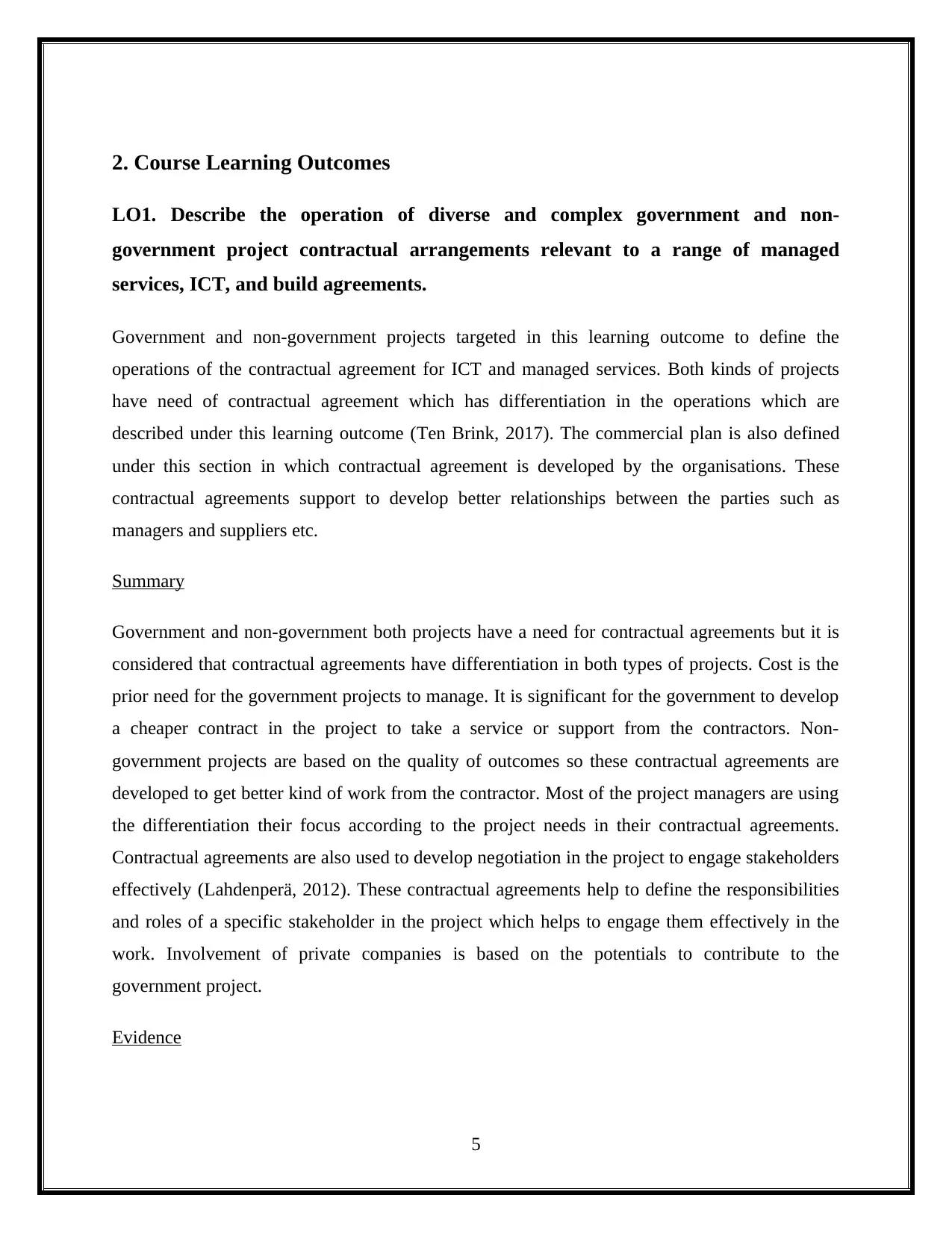
2. Course Learning Outcomes
LO1. Describe the operation of diverse and complex government and non-
government project contractual arrangements relevant to a range of managed
services, ICT, and build agreements.
Government and non-government projects targeted in this learning outcome to define the
operations of the contractual agreement for ICT and managed services. Both kinds of projects
have need of contractual agreement which has differentiation in the operations which are
described under this learning outcome (Ten Brink, 2017). The commercial plan is also defined
under this section in which contractual agreement is developed by the organisations. These
contractual agreements support to develop better relationships between the parties such as
managers and suppliers etc.
Summary
Government and non-government both projects have a need for contractual agreements but it is
considered that contractual agreements have differentiation in both types of projects. Cost is the
prior need for the government projects to manage. It is significant for the government to develop
a cheaper contract in the project to take a service or support from the contractors. Non-
government projects are based on the quality of outcomes so these contractual agreements are
developed to get better kind of work from the contractor. Most of the project managers are using
the differentiation their focus according to the project needs in their contractual agreements.
Contractual agreements are also used to develop negotiation in the project to engage stakeholders
effectively (Lahdenperä, 2012). These contractual agreements help to define the responsibilities
and roles of a specific stakeholder in the project which helps to engage them effectively in the
work. Involvement of private companies is based on the potentials to contribute to the
government project.
Evidence
5
LO1. Describe the operation of diverse and complex government and non-
government project contractual arrangements relevant to a range of managed
services, ICT, and build agreements.
Government and non-government projects targeted in this learning outcome to define the
operations of the contractual agreement for ICT and managed services. Both kinds of projects
have need of contractual agreement which has differentiation in the operations which are
described under this learning outcome (Ten Brink, 2017). The commercial plan is also defined
under this section in which contractual agreement is developed by the organisations. These
contractual agreements support to develop better relationships between the parties such as
managers and suppliers etc.
Summary
Government and non-government both projects have a need for contractual agreements but it is
considered that contractual agreements have differentiation in both types of projects. Cost is the
prior need for the government projects to manage. It is significant for the government to develop
a cheaper contract in the project to take a service or support from the contractors. Non-
government projects are based on the quality of outcomes so these contractual agreements are
developed to get better kind of work from the contractor. Most of the project managers are using
the differentiation their focus according to the project needs in their contractual agreements.
Contractual agreements are also used to develop negotiation in the project to engage stakeholders
effectively (Lahdenperä, 2012). These contractual agreements help to define the responsibilities
and roles of a specific stakeholder in the project which helps to engage them effectively in the
work. Involvement of private companies is based on the potentials to contribute to the
government project.
Evidence
5
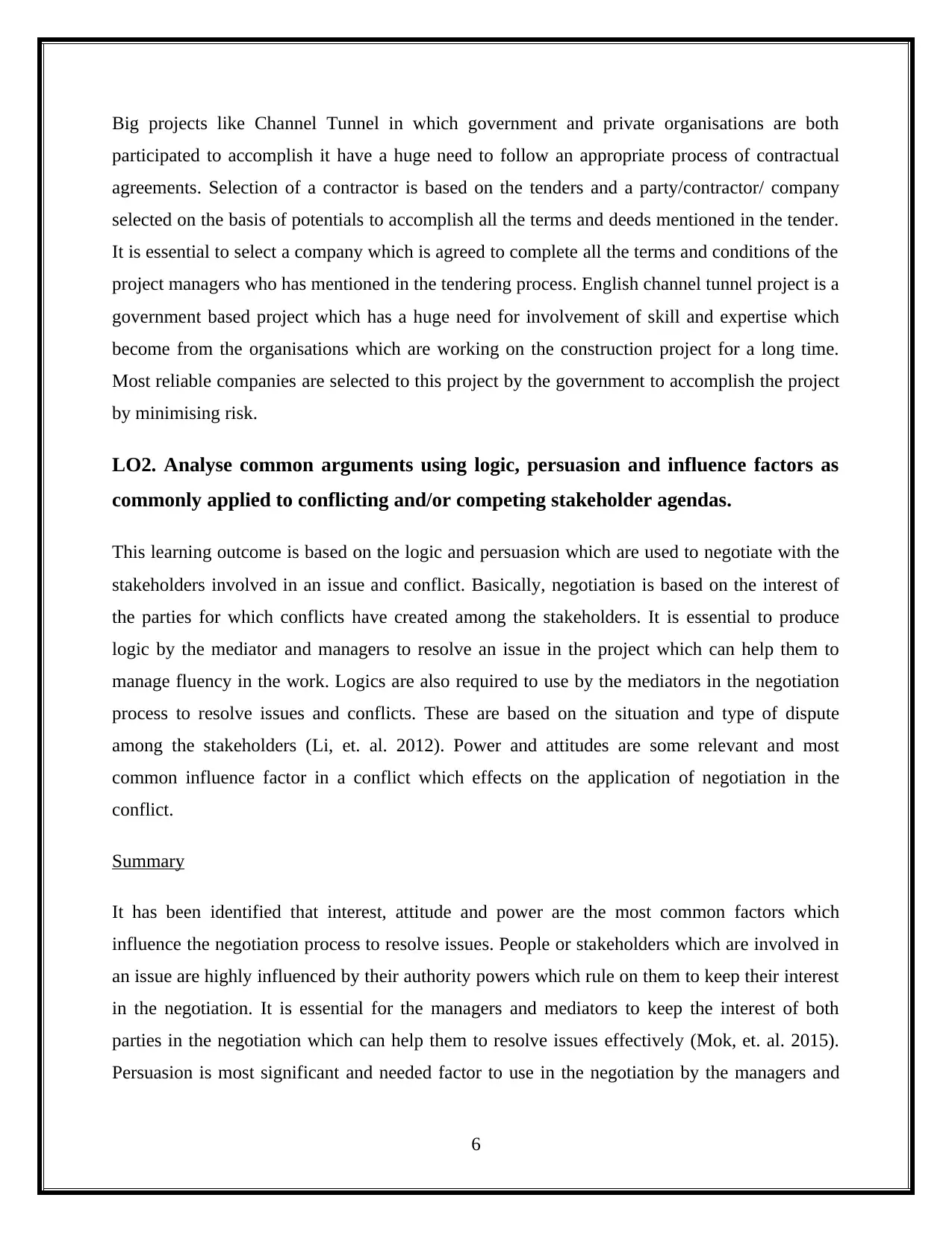
Big projects like Channel Tunnel in which government and private organisations are both
participated to accomplish it have a huge need to follow an appropriate process of contractual
agreements. Selection of a contractor is based on the tenders and a party/contractor/ company
selected on the basis of potentials to accomplish all the terms and deeds mentioned in the tender.
It is essential to select a company which is agreed to complete all the terms and conditions of the
project managers who has mentioned in the tendering process. English channel tunnel project is a
government based project which has a huge need for involvement of skill and expertise which
become from the organisations which are working on the construction project for a long time.
Most reliable companies are selected to this project by the government to accomplish the project
by minimising risk.
LO2. Analyse common arguments using logic, persuasion and influence factors as
commonly applied to conflicting and/or competing stakeholder agendas.
This learning outcome is based on the logic and persuasion which are used to negotiate with the
stakeholders involved in an issue and conflict. Basically, negotiation is based on the interest of
the parties for which conflicts have created among the stakeholders. It is essential to produce
logic by the mediator and managers to resolve an issue in the project which can help them to
manage fluency in the work. Logics are also required to use by the mediators in the negotiation
process to resolve issues and conflicts. These are based on the situation and type of dispute
among the stakeholders (Li, et. al. 2012). Power and attitudes are some relevant and most
common influence factor in a conflict which effects on the application of negotiation in the
conflict.
Summary
It has been identified that interest, attitude and power are the most common factors which
influence the negotiation process to resolve issues. People or stakeholders which are involved in
an issue are highly influenced by their authority powers which rule on them to keep their interest
in the negotiation. It is essential for the managers and mediators to keep the interest of both
parties in the negotiation which can help them to resolve issues effectively (Mok, et. al. 2015).
Persuasion is most significant and needed factor to use in the negotiation by the managers and
6
participated to accomplish it have a huge need to follow an appropriate process of contractual
agreements. Selection of a contractor is based on the tenders and a party/contractor/ company
selected on the basis of potentials to accomplish all the terms and deeds mentioned in the tender.
It is essential to select a company which is agreed to complete all the terms and conditions of the
project managers who has mentioned in the tendering process. English channel tunnel project is a
government based project which has a huge need for involvement of skill and expertise which
become from the organisations which are working on the construction project for a long time.
Most reliable companies are selected to this project by the government to accomplish the project
by minimising risk.
LO2. Analyse common arguments using logic, persuasion and influence factors as
commonly applied to conflicting and/or competing stakeholder agendas.
This learning outcome is based on the logic and persuasion which are used to negotiate with the
stakeholders involved in an issue and conflict. Basically, negotiation is based on the interest of
the parties for which conflicts have created among the stakeholders. It is essential to produce
logic by the mediator and managers to resolve an issue in the project which can help them to
manage fluency in the work. Logics are also required to use by the mediators in the negotiation
process to resolve issues and conflicts. These are based on the situation and type of dispute
among the stakeholders (Li, et. al. 2012). Power and attitudes are some relevant and most
common influence factor in a conflict which effects on the application of negotiation in the
conflict.
Summary
It has been identified that interest, attitude and power are the most common factors which
influence the negotiation process to resolve issues. People or stakeholders which are involved in
an issue are highly influenced by their authority powers which rule on them to keep their interest
in the negotiation. It is essential for the managers and mediators to keep the interest of both
parties in the negotiation which can help them to resolve issues effectively (Mok, et. al. 2015).
Persuasion is most significant and needed factor to use in the negotiation by the managers and
6
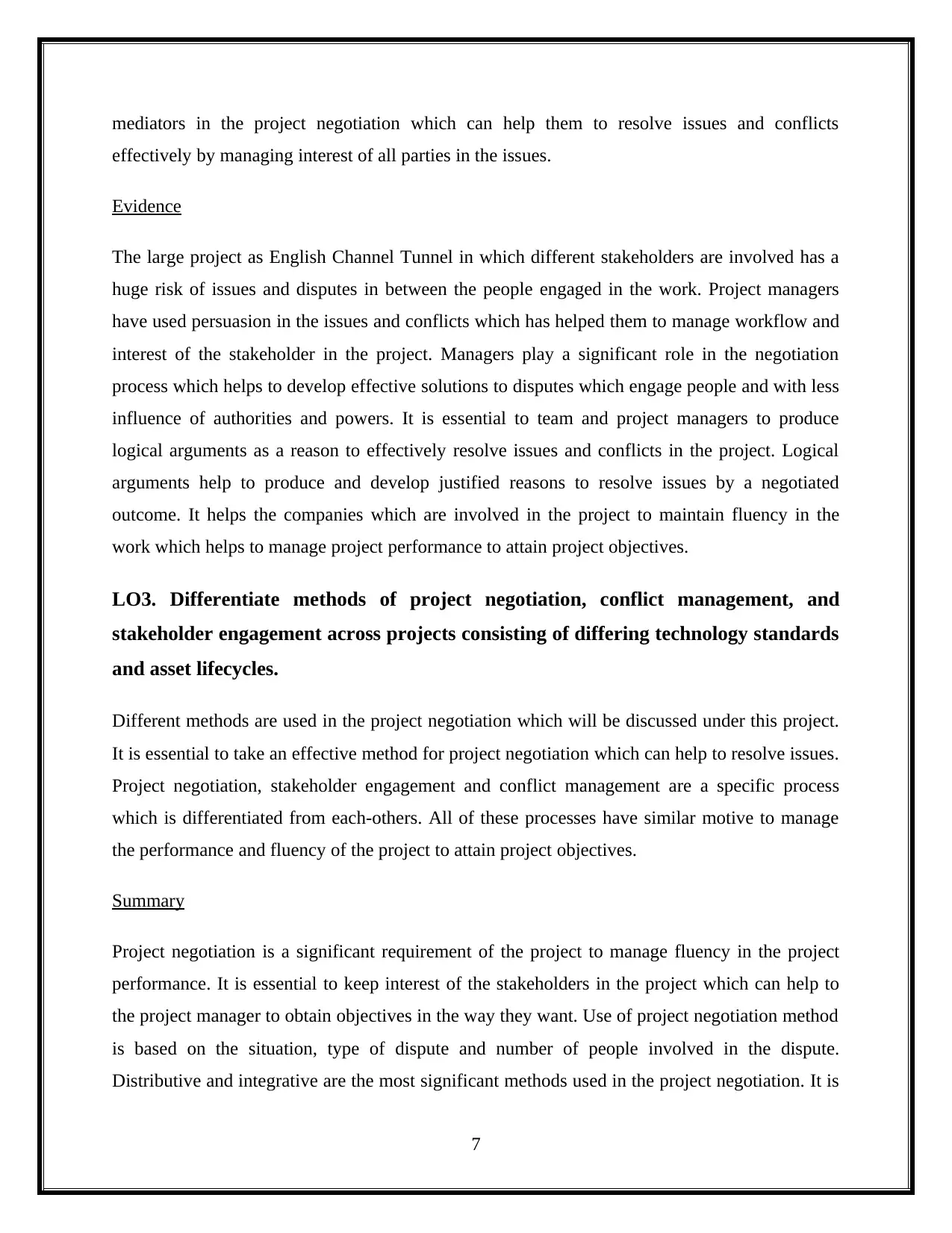
mediators in the project negotiation which can help them to resolve issues and conflicts
effectively by managing interest of all parties in the issues.
Evidence
The large project as English Channel Tunnel in which different stakeholders are involved has a
huge risk of issues and disputes in between the people engaged in the work. Project managers
have used persuasion in the issues and conflicts which has helped them to manage workflow and
interest of the stakeholder in the project. Managers play a significant role in the negotiation
process which helps to develop effective solutions to disputes which engage people and with less
influence of authorities and powers. It is essential to team and project managers to produce
logical arguments as a reason to effectively resolve issues and conflicts in the project. Logical
arguments help to produce and develop justified reasons to resolve issues by a negotiated
outcome. It helps the companies which are involved in the project to maintain fluency in the
work which helps to manage project performance to attain project objectives.
LO3. Differentiate methods of project negotiation, conflict management, and
stakeholder engagement across projects consisting of differing technology standards
and asset lifecycles.
Different methods are used in the project negotiation which will be discussed under this project.
It is essential to take an effective method for project negotiation which can help to resolve issues.
Project negotiation, stakeholder engagement and conflict management are a specific process
which is differentiated from each-others. All of these processes have similar motive to manage
the performance and fluency of the project to attain project objectives.
Summary
Project negotiation is a significant requirement of the project to manage fluency in the project
performance. It is essential to keep interest of the stakeholders in the project which can help to
the project manager to obtain objectives in the way they want. Use of project negotiation method
is based on the situation, type of dispute and number of people involved in the dispute.
Distributive and integrative are the most significant methods used in the project negotiation. It is
7
effectively by managing interest of all parties in the issues.
Evidence
The large project as English Channel Tunnel in which different stakeholders are involved has a
huge risk of issues and disputes in between the people engaged in the work. Project managers
have used persuasion in the issues and conflicts which has helped them to manage workflow and
interest of the stakeholder in the project. Managers play a significant role in the negotiation
process which helps to develop effective solutions to disputes which engage people and with less
influence of authorities and powers. It is essential to team and project managers to produce
logical arguments as a reason to effectively resolve issues and conflicts in the project. Logical
arguments help to produce and develop justified reasons to resolve issues by a negotiated
outcome. It helps the companies which are involved in the project to maintain fluency in the
work which helps to manage project performance to attain project objectives.
LO3. Differentiate methods of project negotiation, conflict management, and
stakeholder engagement across projects consisting of differing technology standards
and asset lifecycles.
Different methods are used in the project negotiation which will be discussed under this project.
It is essential to take an effective method for project negotiation which can help to resolve issues.
Project negotiation, stakeholder engagement and conflict management are a specific process
which is differentiated from each-others. All of these processes have similar motive to manage
the performance and fluency of the project to attain project objectives.
Summary
Project negotiation is a significant requirement of the project to manage fluency in the project
performance. It is essential to keep interest of the stakeholders in the project which can help to
the project manager to obtain objectives in the way they want. Use of project negotiation method
is based on the situation, type of dispute and number of people involved in the dispute.
Distributive and integrative are the most significant methods used in the project negotiation. It is
7
Paraphrase This Document
Need a fresh take? Get an instant paraphrase of this document with our AI Paraphraser
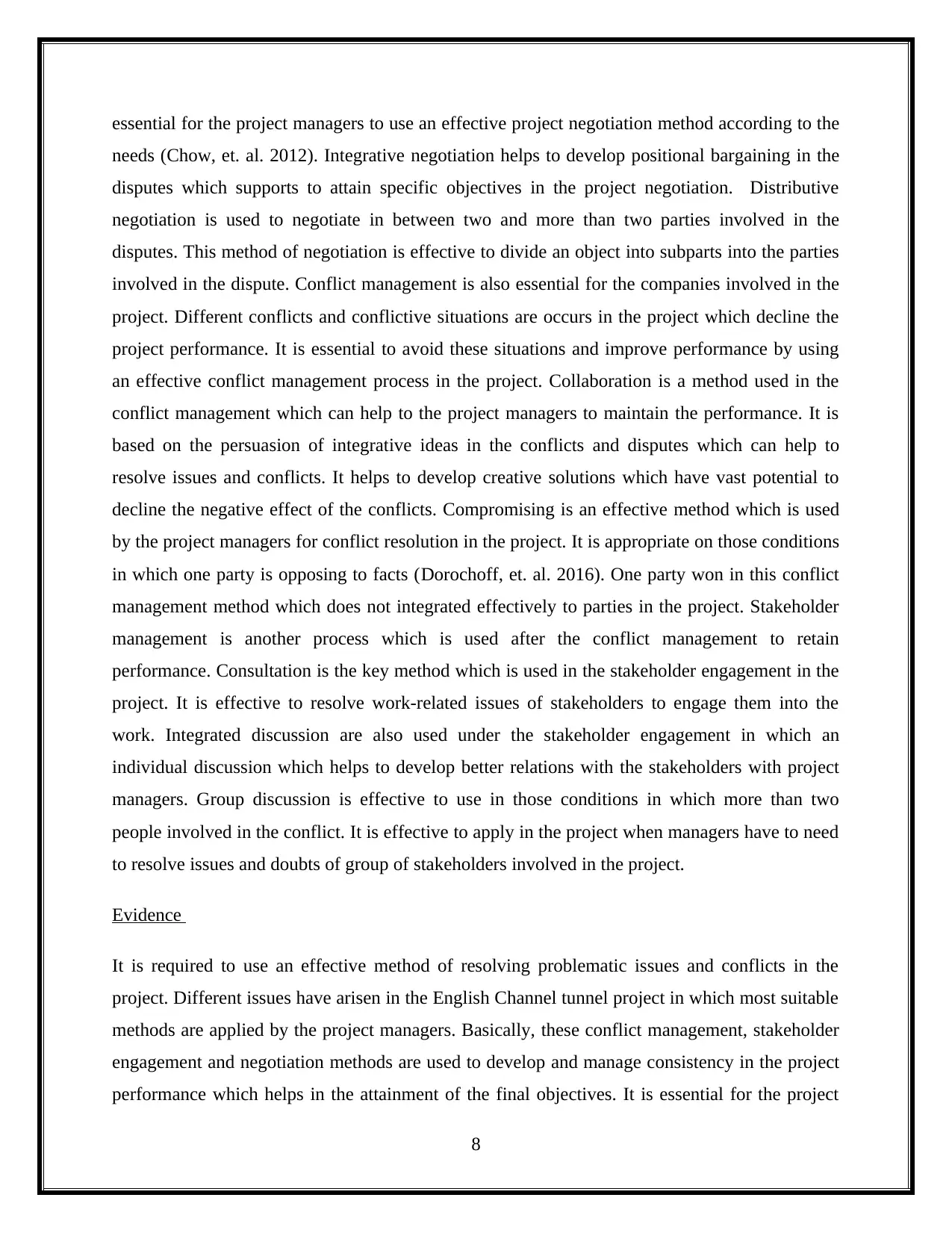
essential for the project managers to use an effective project negotiation method according to the
needs (Chow, et. al. 2012). Integrative negotiation helps to develop positional bargaining in the
disputes which supports to attain specific objectives in the project negotiation. Distributive
negotiation is used to negotiate in between two and more than two parties involved in the
disputes. This method of negotiation is effective to divide an object into subparts into the parties
involved in the dispute. Conflict management is also essential for the companies involved in the
project. Different conflicts and conflictive situations are occurs in the project which decline the
project performance. It is essential to avoid these situations and improve performance by using
an effective conflict management process in the project. Collaboration is a method used in the
conflict management which can help to the project managers to maintain the performance. It is
based on the persuasion of integrative ideas in the conflicts and disputes which can help to
resolve issues and conflicts. It helps to develop creative solutions which have vast potential to
decline the negative effect of the conflicts. Compromising is an effective method which is used
by the project managers for conflict resolution in the project. It is appropriate on those conditions
in which one party is opposing to facts (Dorochoff, et. al. 2016). One party won in this conflict
management method which does not integrated effectively to parties in the project. Stakeholder
management is another process which is used after the conflict management to retain
performance. Consultation is the key method which is used in the stakeholder engagement in the
project. It is effective to resolve work-related issues of stakeholders to engage them into the
work. Integrated discussion are also used under the stakeholder engagement in which an
individual discussion which helps to develop better relations with the stakeholders with project
managers. Group discussion is effective to use in those conditions in which more than two
people involved in the conflict. It is effective to apply in the project when managers have to need
to resolve issues and doubts of group of stakeholders involved in the project.
Evidence
It is required to use an effective method of resolving problematic issues and conflicts in the
project. Different issues have arisen in the English Channel tunnel project in which most suitable
methods are applied by the project managers. Basically, these conflict management, stakeholder
engagement and negotiation methods are used to develop and manage consistency in the project
performance which helps in the attainment of the final objectives. It is essential for the project
8
needs (Chow, et. al. 2012). Integrative negotiation helps to develop positional bargaining in the
disputes which supports to attain specific objectives in the project negotiation. Distributive
negotiation is used to negotiate in between two and more than two parties involved in the
disputes. This method of negotiation is effective to divide an object into subparts into the parties
involved in the dispute. Conflict management is also essential for the companies involved in the
project. Different conflicts and conflictive situations are occurs in the project which decline the
project performance. It is essential to avoid these situations and improve performance by using
an effective conflict management process in the project. Collaboration is a method used in the
conflict management which can help to the project managers to maintain the performance. It is
based on the persuasion of integrative ideas in the conflicts and disputes which can help to
resolve issues and conflicts. It helps to develop creative solutions which have vast potential to
decline the negative effect of the conflicts. Compromising is an effective method which is used
by the project managers for conflict resolution in the project. It is appropriate on those conditions
in which one party is opposing to facts (Dorochoff, et. al. 2016). One party won in this conflict
management method which does not integrated effectively to parties in the project. Stakeholder
management is another process which is used after the conflict management to retain
performance. Consultation is the key method which is used in the stakeholder engagement in the
project. It is effective to resolve work-related issues of stakeholders to engage them into the
work. Integrated discussion are also used under the stakeholder engagement in which an
individual discussion which helps to develop better relations with the stakeholders with project
managers. Group discussion is effective to use in those conditions in which more than two
people involved in the conflict. It is effective to apply in the project when managers have to need
to resolve issues and doubts of group of stakeholders involved in the project.
Evidence
It is required to use an effective method of resolving problematic issues and conflicts in the
project. Different issues have arisen in the English Channel tunnel project in which most suitable
methods are applied by the project managers. Basically, these conflict management, stakeholder
engagement and negotiation methods are used to develop and manage consistency in the project
performance which helps in the attainment of the final objectives. It is essential for the project
8
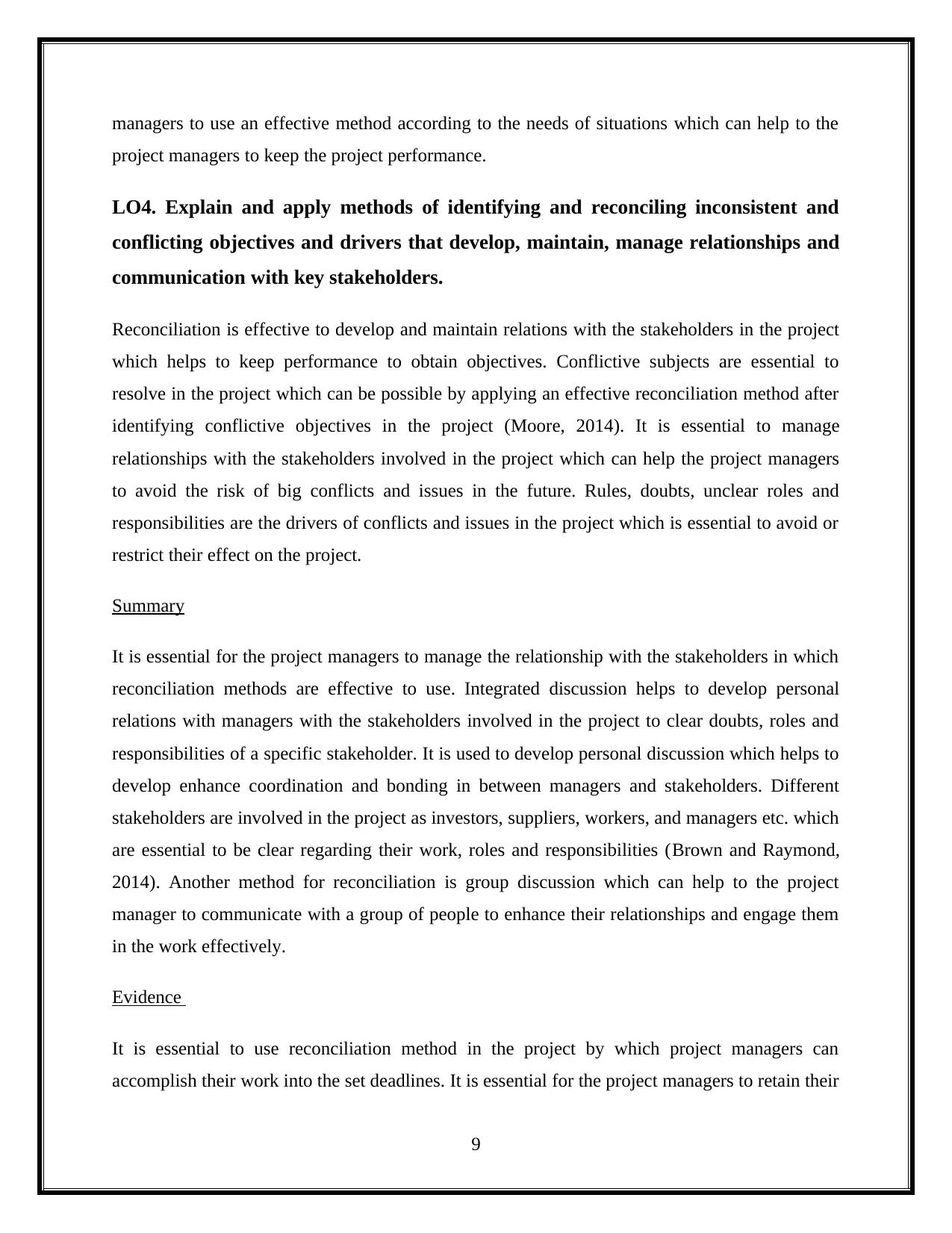
managers to use an effective method according to the needs of situations which can help to the
project managers to keep the project performance.
LO4. Explain and apply methods of identifying and reconciling inconsistent and
conflicting objectives and drivers that develop, maintain, manage relationships and
communication with key stakeholders.
Reconciliation is effective to develop and maintain relations with the stakeholders in the project
which helps to keep performance to obtain objectives. Conflictive subjects are essential to
resolve in the project which can be possible by applying an effective reconciliation method after
identifying conflictive objectives in the project (Moore, 2014). It is essential to manage
relationships with the stakeholders involved in the project which can help the project managers
to avoid the risk of big conflicts and issues in the future. Rules, doubts, unclear roles and
responsibilities are the drivers of conflicts and issues in the project which is essential to avoid or
restrict their effect on the project.
Summary
It is essential for the project managers to manage the relationship with the stakeholders in which
reconciliation methods are effective to use. Integrated discussion helps to develop personal
relations with managers with the stakeholders involved in the project to clear doubts, roles and
responsibilities of a specific stakeholder. It is used to develop personal discussion which helps to
develop enhance coordination and bonding in between managers and stakeholders. Different
stakeholders are involved in the project as investors, suppliers, workers, and managers etc. which
are essential to be clear regarding their work, roles and responsibilities (Brown and Raymond,
2014). Another method for reconciliation is group discussion which can help to the project
manager to communicate with a group of people to enhance their relationships and engage them
in the work effectively.
Evidence
It is essential to use reconciliation method in the project by which project managers can
accomplish their work into the set deadlines. It is essential for the project managers to retain their
9
project managers to keep the project performance.
LO4. Explain and apply methods of identifying and reconciling inconsistent and
conflicting objectives and drivers that develop, maintain, manage relationships and
communication with key stakeholders.
Reconciliation is effective to develop and maintain relations with the stakeholders in the project
which helps to keep performance to obtain objectives. Conflictive subjects are essential to
resolve in the project which can be possible by applying an effective reconciliation method after
identifying conflictive objectives in the project (Moore, 2014). It is essential to manage
relationships with the stakeholders involved in the project which can help the project managers
to avoid the risk of big conflicts and issues in the future. Rules, doubts, unclear roles and
responsibilities are the drivers of conflicts and issues in the project which is essential to avoid or
restrict their effect on the project.
Summary
It is essential for the project managers to manage the relationship with the stakeholders in which
reconciliation methods are effective to use. Integrated discussion helps to develop personal
relations with managers with the stakeholders involved in the project to clear doubts, roles and
responsibilities of a specific stakeholder. It is used to develop personal discussion which helps to
develop enhance coordination and bonding in between managers and stakeholders. Different
stakeholders are involved in the project as investors, suppliers, workers, and managers etc. which
are essential to be clear regarding their work, roles and responsibilities (Brown and Raymond,
2014). Another method for reconciliation is group discussion which can help to the project
manager to communicate with a group of people to enhance their relationships and engage them
in the work effectively.
Evidence
It is essential to use reconciliation method in the project by which project managers can
accomplish their work into the set deadlines. It is essential for the project managers to retain their
9

best performance by which they can attain their objectives in an effective manner. The
accomplishment of the project in the set deadlines is evidence that coordination and bonding in
between the teammates, managers and stakeholders are effective. Profitability in the project is
also can be managed by the use of reconciliation method in the project. group discussion tactic is
generally used by the project managers to communicate and share their opinion with a group of
stakeholders and employees involved in the project to develop better bonding and relationship
with them.
LO5. Explain the consequences of project delays, disruptions, and changes to
planned activities and the methods for claims variations, liquidated damages,
contract entitlements, and arbitration.
This topic is based to develop learning on the consequences related with the project delays,
obstacles and change in the predetermined activities. It also has provided a path to identify the
consequences related to the contract entitlement, claims variations, contract entitlement and
liquidated damages on the project (Sunjka and Jacob, 2013). It is essential for the project
managers to avoid the change in the planned activities which disrupts the performance and
develop variance in the working schedules. Final outcomes are mainly affected by these reasons
so it is essential to avoid these reasons and maintain and retain performance.
Summary
Project delays are the biggest risk for a project manager which influences the values of the
outcomes. It is essential for the project managers to use PM tools and techniques to avoid delays
in the schedule. Outcomes are related to the objectives which are essential to get on a specific
time. Cost is another consequence which enhanced by the project delays creates a huge financial
pressure on the companies, managers and investors involved in the project. Mainly disruptions,
delays and change in planned activities effects on the outcomes, cost, price, the value of
outcomes and as well as on the people involved in the project (Hampton, et. al. 2012).
Motivational level declines due to delays, disruptions and change in the planned activities so it is
essential for the project managers to avoid these situations in the project.
Evidence
10
accomplishment of the project in the set deadlines is evidence that coordination and bonding in
between the teammates, managers and stakeholders are effective. Profitability in the project is
also can be managed by the use of reconciliation method in the project. group discussion tactic is
generally used by the project managers to communicate and share their opinion with a group of
stakeholders and employees involved in the project to develop better bonding and relationship
with them.
LO5. Explain the consequences of project delays, disruptions, and changes to
planned activities and the methods for claims variations, liquidated damages,
contract entitlements, and arbitration.
This topic is based to develop learning on the consequences related with the project delays,
obstacles and change in the predetermined activities. It also has provided a path to identify the
consequences related to the contract entitlement, claims variations, contract entitlement and
liquidated damages on the project (Sunjka and Jacob, 2013). It is essential for the project
managers to avoid the change in the planned activities which disrupts the performance and
develop variance in the working schedules. Final outcomes are mainly affected by these reasons
so it is essential to avoid these reasons and maintain and retain performance.
Summary
Project delays are the biggest risk for a project manager which influences the values of the
outcomes. It is essential for the project managers to use PM tools and techniques to avoid delays
in the schedule. Outcomes are related to the objectives which are essential to get on a specific
time. Cost is another consequence which enhanced by the project delays creates a huge financial
pressure on the companies, managers and investors involved in the project. Mainly disruptions,
delays and change in planned activities effects on the outcomes, cost, price, the value of
outcomes and as well as on the people involved in the project (Hampton, et. al. 2012).
Motivational level declines due to delays, disruptions and change in the planned activities so it is
essential for the project managers to avoid these situations in the project.
Evidence
10
Secure Best Marks with AI Grader
Need help grading? Try our AI Grader for instant feedback on your assignments.
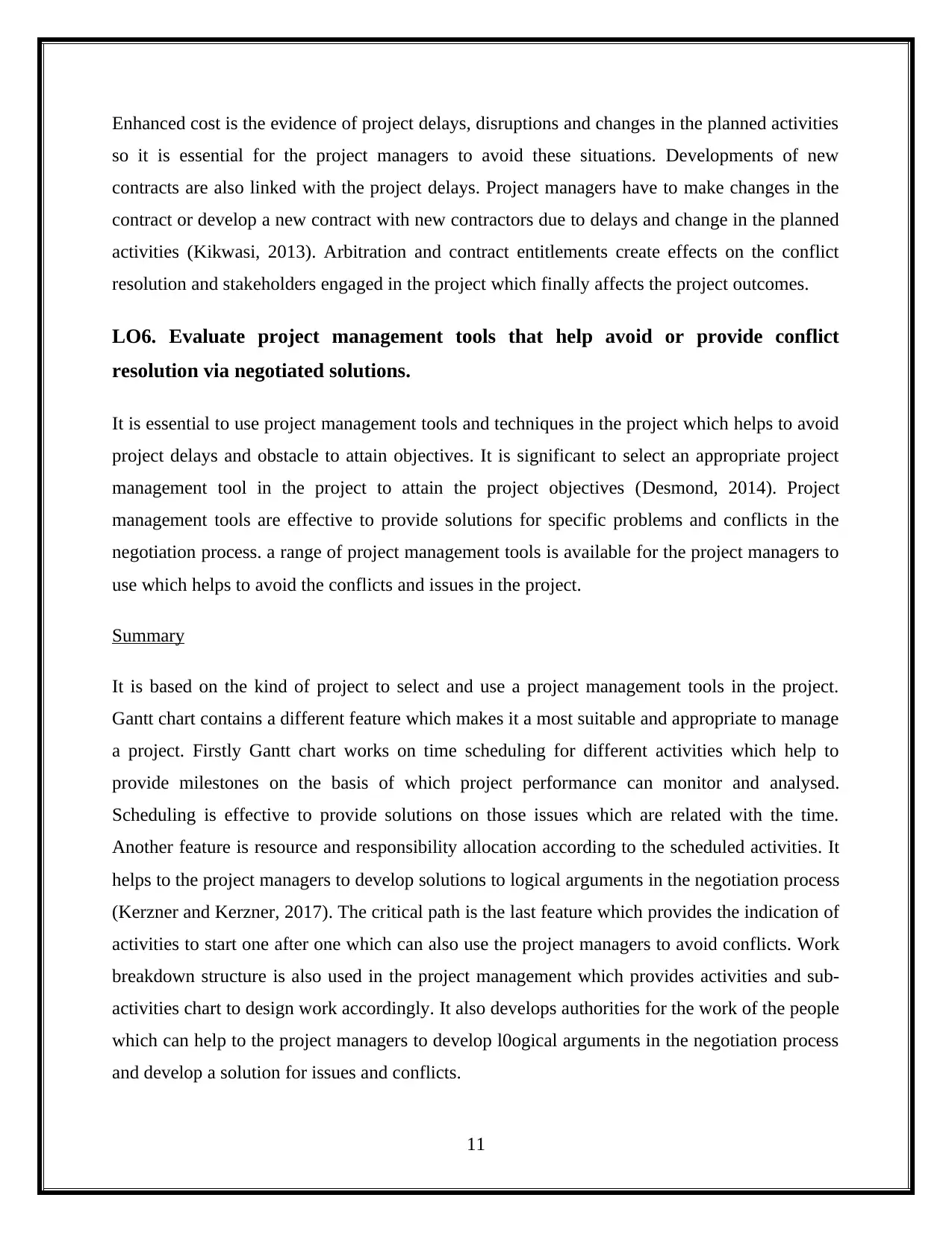
Enhanced cost is the evidence of project delays, disruptions and changes in the planned activities
so it is essential for the project managers to avoid these situations. Developments of new
contracts are also linked with the project delays. Project managers have to make changes in the
contract or develop a new contract with new contractors due to delays and change in the planned
activities (Kikwasi, 2013). Arbitration and contract entitlements create effects on the conflict
resolution and stakeholders engaged in the project which finally affects the project outcomes.
LO6. Evaluate project management tools that help avoid or provide conflict
resolution via negotiated solutions.
It is essential to use project management tools and techniques in the project which helps to avoid
project delays and obstacle to attain objectives. It is significant to select an appropriate project
management tool in the project to attain the project objectives (Desmond, 2014). Project
management tools are effective to provide solutions for specific problems and conflicts in the
negotiation process. a range of project management tools is available for the project managers to
use which helps to avoid the conflicts and issues in the project.
Summary
It is based on the kind of project to select and use a project management tools in the project.
Gantt chart contains a different feature which makes it a most suitable and appropriate to manage
a project. Firstly Gantt chart works on time scheduling for different activities which help to
provide milestones on the basis of which project performance can monitor and analysed.
Scheduling is effective to provide solutions on those issues which are related with the time.
Another feature is resource and responsibility allocation according to the scheduled activities. It
helps to the project managers to develop solutions to logical arguments in the negotiation process
(Kerzner and Kerzner, 2017). The critical path is the last feature which provides the indication of
activities to start one after one which can also use the project managers to avoid conflicts. Work
breakdown structure is also used in the project management which provides activities and sub-
activities chart to design work accordingly. It also develops authorities for the work of the people
which can help to the project managers to develop l0ogical arguments in the negotiation process
and develop a solution for issues and conflicts.
11
so it is essential for the project managers to avoid these situations. Developments of new
contracts are also linked with the project delays. Project managers have to make changes in the
contract or develop a new contract with new contractors due to delays and change in the planned
activities (Kikwasi, 2013). Arbitration and contract entitlements create effects on the conflict
resolution and stakeholders engaged in the project which finally affects the project outcomes.
LO6. Evaluate project management tools that help avoid or provide conflict
resolution via negotiated solutions.
It is essential to use project management tools and techniques in the project which helps to avoid
project delays and obstacle to attain objectives. It is significant to select an appropriate project
management tool in the project to attain the project objectives (Desmond, 2014). Project
management tools are effective to provide solutions for specific problems and conflicts in the
negotiation process. a range of project management tools is available for the project managers to
use which helps to avoid the conflicts and issues in the project.
Summary
It is based on the kind of project to select and use a project management tools in the project.
Gantt chart contains a different feature which makes it a most suitable and appropriate to manage
a project. Firstly Gantt chart works on time scheduling for different activities which help to
provide milestones on the basis of which project performance can monitor and analysed.
Scheduling is effective to provide solutions on those issues which are related with the time.
Another feature is resource and responsibility allocation according to the scheduled activities. It
helps to the project managers to develop solutions to logical arguments in the negotiation process
(Kerzner and Kerzner, 2017). The critical path is the last feature which provides the indication of
activities to start one after one which can also use the project managers to avoid conflicts. Work
breakdown structure is also used in the project management which provides activities and sub-
activities chart to design work accordingly. It also develops authorities for the work of the people
which can help to the project managers to develop l0ogical arguments in the negotiation process
and develop a solution for issues and conflicts.
11
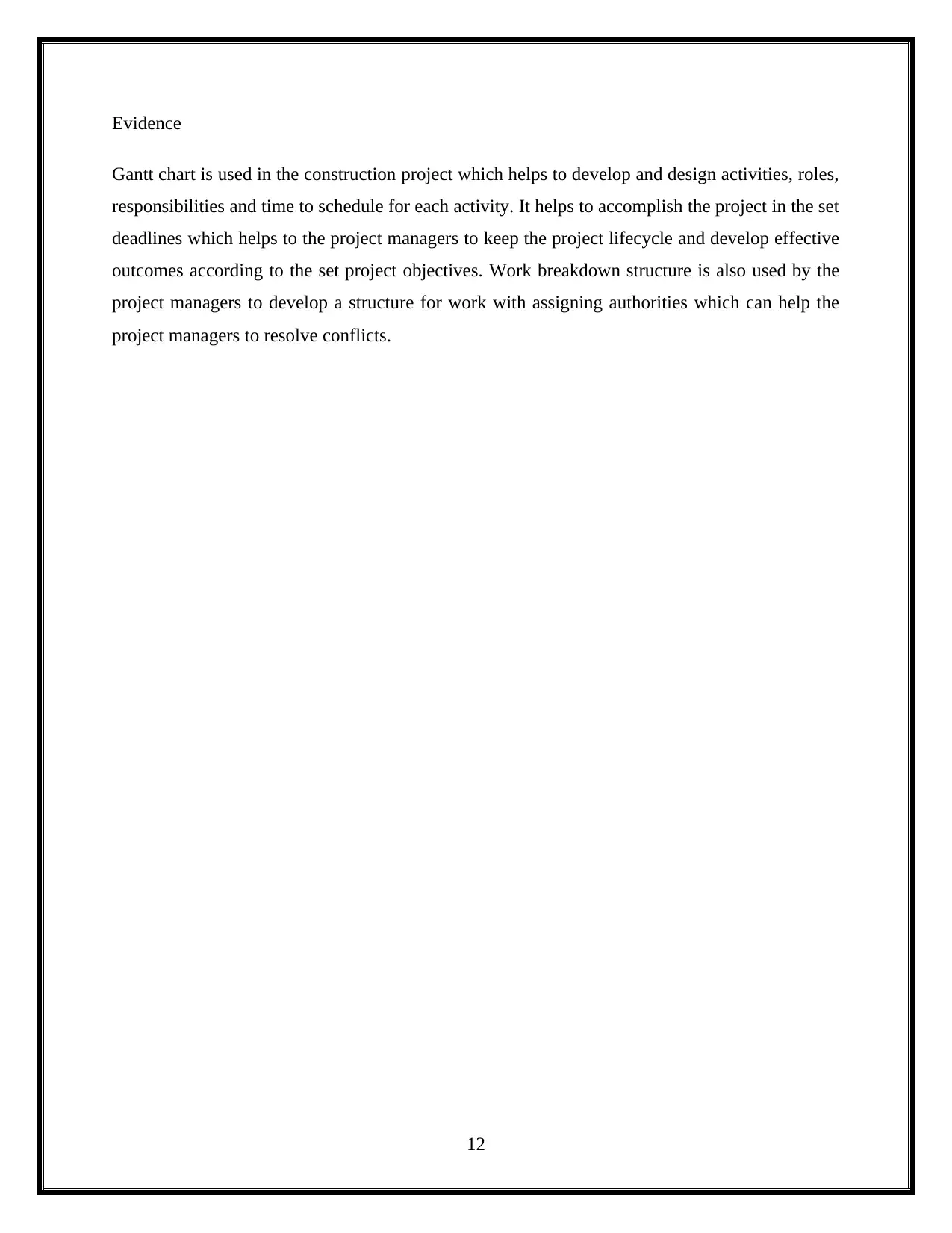
Evidence
Gantt chart is used in the construction project which helps to develop and design activities, roles,
responsibilities and time to schedule for each activity. It helps to accomplish the project in the set
deadlines which helps to the project managers to keep the project lifecycle and develop effective
outcomes according to the set project objectives. Work breakdown structure is also used by the
project managers to develop a structure for work with assigning authorities which can help the
project managers to resolve conflicts.
12
Gantt chart is used in the construction project which helps to develop and design activities, roles,
responsibilities and time to schedule for each activity. It helps to accomplish the project in the set
deadlines which helps to the project managers to keep the project lifecycle and develop effective
outcomes according to the set project objectives. Work breakdown structure is also used by the
project managers to develop a structure for work with assigning authorities which can help the
project managers to resolve conflicts.
12

3. Discussion and Conclusion
Weekly portfolios are based on topics which provide learning in each week which will be
discussed under the points given below:
Week 1: It is based on the operations of government and non-government project contractual
agreement from which I have learned that government projects are mostly focused on the cost as
compared with the non-government projects.
Week 2: Logical arguments are effective to use in the project negotiation to provide justified
reasons to the stakeholders involved in the project. It is essential to use persuasion to keep the
relationships and manage the conflict effectively.
Week 3: Structural, behavioural, strategic, integrated and distributive approaches of negotiations
are learned in this week. The structural approach is appropriate to attain objectives but on the
other side behavioural approach is effective to manage relations with stakeholders in the project.
Week 4: I have learned the use of conflict management in the project under this week. It is
significant to understand and develop collaboration and compromise with stakeholders in the
project.
Week 5: Stakeholder engagement is essential to use after conflict management and negotiation
process which helps to manage the motivation of stakeholder in the project.
Week 6: Reconciling is related to the relationship management in the project with the
stakeholder. Group discussion is effective to communicate and manage relationships with a large
number of people in the project.
Week 8: Integrated discussion is also part of reconciling inconsistent and conflicts drivers in the
project. It enhances people engagement in the project which declines the scope of inconsistency.
Week 9: Disruptions and delays are mainly effects on the project outcomes and cost of the
project which is essential to manage.
13
Weekly portfolios are based on topics which provide learning in each week which will be
discussed under the points given below:
Week 1: It is based on the operations of government and non-government project contractual
agreement from which I have learned that government projects are mostly focused on the cost as
compared with the non-government projects.
Week 2: Logical arguments are effective to use in the project negotiation to provide justified
reasons to the stakeholders involved in the project. It is essential to use persuasion to keep the
relationships and manage the conflict effectively.
Week 3: Structural, behavioural, strategic, integrated and distributive approaches of negotiations
are learned in this week. The structural approach is appropriate to attain objectives but on the
other side behavioural approach is effective to manage relations with stakeholders in the project.
Week 4: I have learned the use of conflict management in the project under this week. It is
significant to understand and develop collaboration and compromise with stakeholders in the
project.
Week 5: Stakeholder engagement is essential to use after conflict management and negotiation
process which helps to manage the motivation of stakeholder in the project.
Week 6: Reconciling is related to the relationship management in the project with the
stakeholder. Group discussion is effective to communicate and manage relationships with a large
number of people in the project.
Week 8: Integrated discussion is also part of reconciling inconsistent and conflicts drivers in the
project. It enhances people engagement in the project which declines the scope of inconsistency.
Week 9: Disruptions and delays are mainly effects on the project outcomes and cost of the
project which is essential to manage.
13
Paraphrase This Document
Need a fresh take? Get an instant paraphrase of this document with our AI Paraphraser
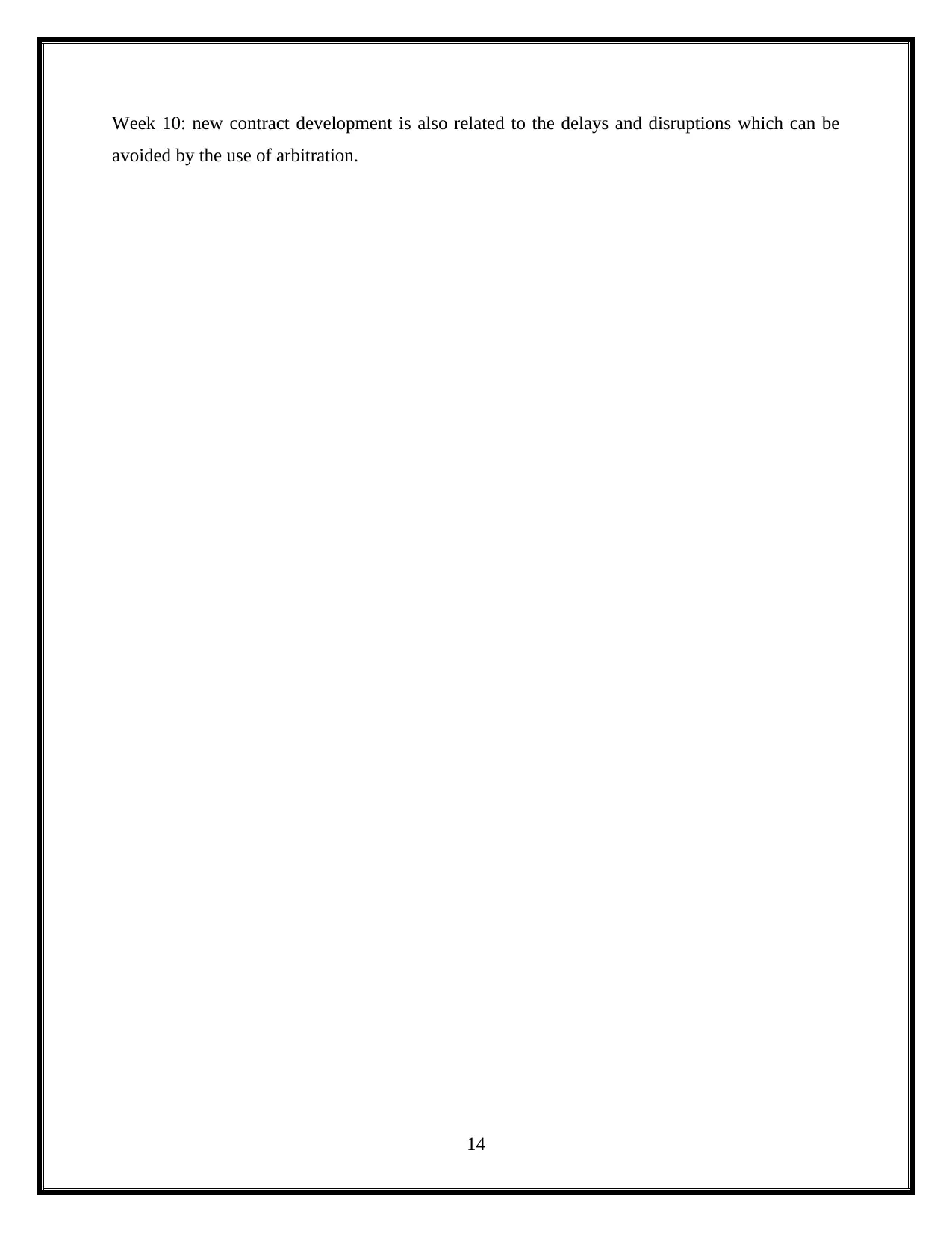
Week 10: new contract development is also related to the delays and disruptions which can be
avoided by the use of arbitration.
14
avoided by the use of arbitration.
14

4. References
Brown, G. and Raymond, C.M., 2014. Methods for identifying land use conflict potential
using participatory mapping. Landscape and Urban Planning, 122, pp.196-208.
Chow, P.T., Cheung, S.O. and Yiu, T.W., 2012. A cusp catastrophe model of withdrawal
in construction project dispute negotiation. Automation in Construction, 22, pp.597-604.
Desmond, C., 2014. Project management tools. IEEE Engineering Management
Review, 42(4), pp.11-12.
Dorochoff, N., 2016. Negotiation Basics for Cultural Resource Managers. Routledge.
Hampton, G., Baldwin, A.N. and Holt, G., 2012. Project delays and cost: stakeholder
perceptions of traditional v. PPP procurement. Journal of Financial Management of Property
and Construction, 17(1), pp.73-91.
Kerzner, H. and Kerzner, H.R., 2017. Project management: a systems approach to
planning, scheduling, and controlling. John Wiley & Sons.
Kikwasi, G., 2013, February. Causes and effects of delays and disruptions in construction
projects in Tanzania. In Australasian Journal of Construction Economics and Building-
Conference Series (Vol. 1, No. 2, pp. 52-59).
Lahdenperä, P., 2012. Making sense of the multi-party contractual arrangements of
project partnering, project alliancing and integrated project delivery. Construction
Management and Economics, 30(1), pp.57-79.
Li, T.H., Ng, S.T. and Skitmore, M., 2012. Conflict or consensus: An investigation of
stakeholder concerns during the participation process of major infrastructure and construction
projects in Hong Kong. Habitat international, 36(2), pp.333-342.
Mok, K.Y., Shen, G.Q. and Yang, J., 2015. Stakeholder management studies in mega
construction projects: A review and future directions. International Journal of Project
Management, 33(2), pp.446-457.
Moore, C.W., 2014. The mediation process: Practical strategies for resolving conflict.
John Wiley & Sons.
Sunjka, B.P. and Jacob, U., 2013. Significant causes and effects of project delays in the
Niger delta region, Nigeria. Southern African Institute of Industrial Engineering.
15
Brown, G. and Raymond, C.M., 2014. Methods for identifying land use conflict potential
using participatory mapping. Landscape and Urban Planning, 122, pp.196-208.
Chow, P.T., Cheung, S.O. and Yiu, T.W., 2012. A cusp catastrophe model of withdrawal
in construction project dispute negotiation. Automation in Construction, 22, pp.597-604.
Desmond, C., 2014. Project management tools. IEEE Engineering Management
Review, 42(4), pp.11-12.
Dorochoff, N., 2016. Negotiation Basics for Cultural Resource Managers. Routledge.
Hampton, G., Baldwin, A.N. and Holt, G., 2012. Project delays and cost: stakeholder
perceptions of traditional v. PPP procurement. Journal of Financial Management of Property
and Construction, 17(1), pp.73-91.
Kerzner, H. and Kerzner, H.R., 2017. Project management: a systems approach to
planning, scheduling, and controlling. John Wiley & Sons.
Kikwasi, G., 2013, February. Causes and effects of delays and disruptions in construction
projects in Tanzania. In Australasian Journal of Construction Economics and Building-
Conference Series (Vol. 1, No. 2, pp. 52-59).
Lahdenperä, P., 2012. Making sense of the multi-party contractual arrangements of
project partnering, project alliancing and integrated project delivery. Construction
Management and Economics, 30(1), pp.57-79.
Li, T.H., Ng, S.T. and Skitmore, M., 2012. Conflict or consensus: An investigation of
stakeholder concerns during the participation process of major infrastructure and construction
projects in Hong Kong. Habitat international, 36(2), pp.333-342.
Mok, K.Y., Shen, G.Q. and Yang, J., 2015. Stakeholder management studies in mega
construction projects: A review and future directions. International Journal of Project
Management, 33(2), pp.446-457.
Moore, C.W., 2014. The mediation process: Practical strategies for resolving conflict.
John Wiley & Sons.
Sunjka, B.P. and Jacob, U., 2013. Significant causes and effects of project delays in the
Niger delta region, Nigeria. Southern African Institute of Industrial Engineering.
15
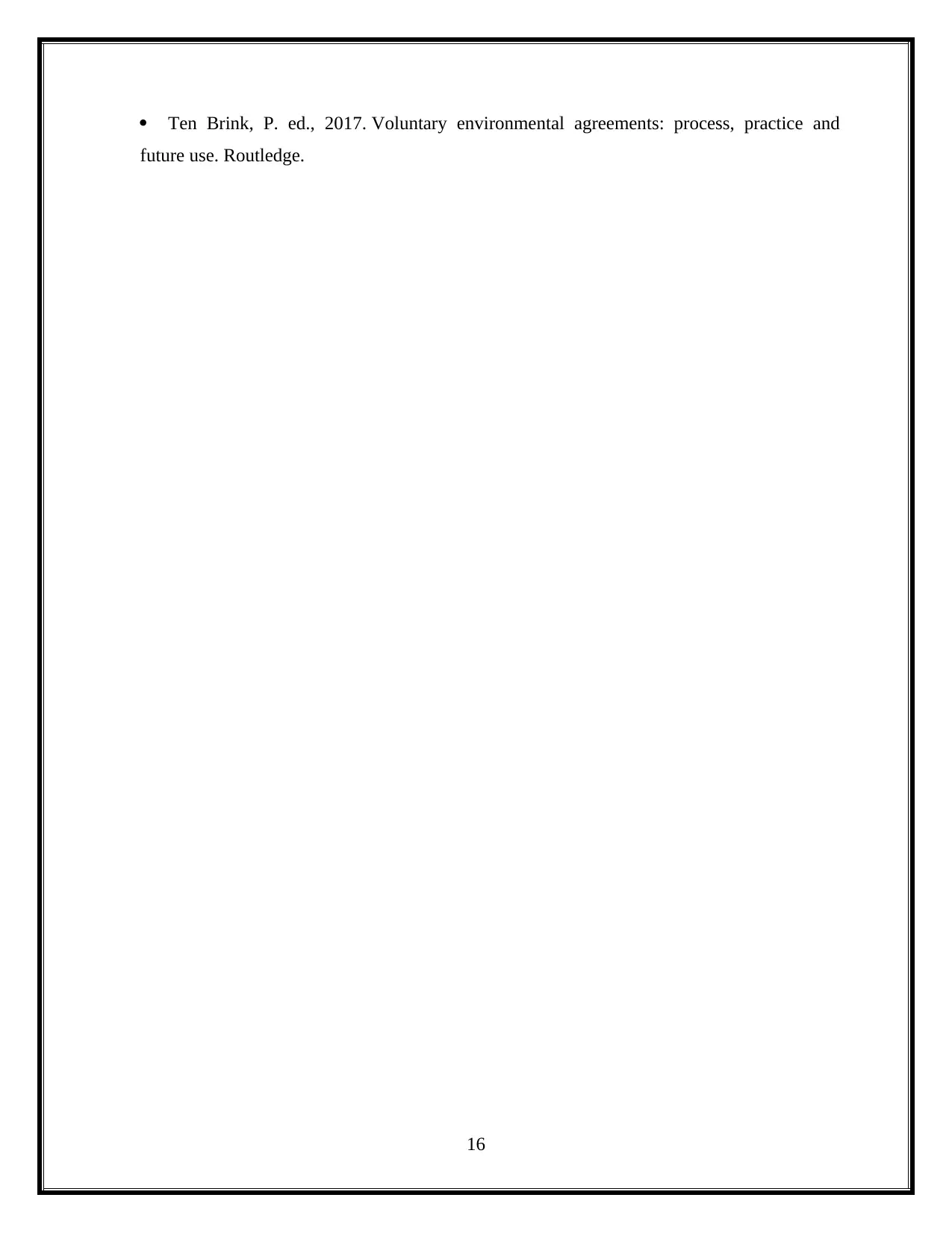
Ten Brink, P. ed., 2017. Voluntary environmental agreements: process, practice and
future use. Routledge.
16
future use. Routledge.
16
Secure Best Marks with AI Grader
Need help grading? Try our AI Grader for instant feedback on your assignments.

5. Appendices
Week 1
Week 2
Week 3
Week 4
Week 5
Week 6
17
Week 1
Week 2
Week 3
Week 4
Week 5
Week 6
17
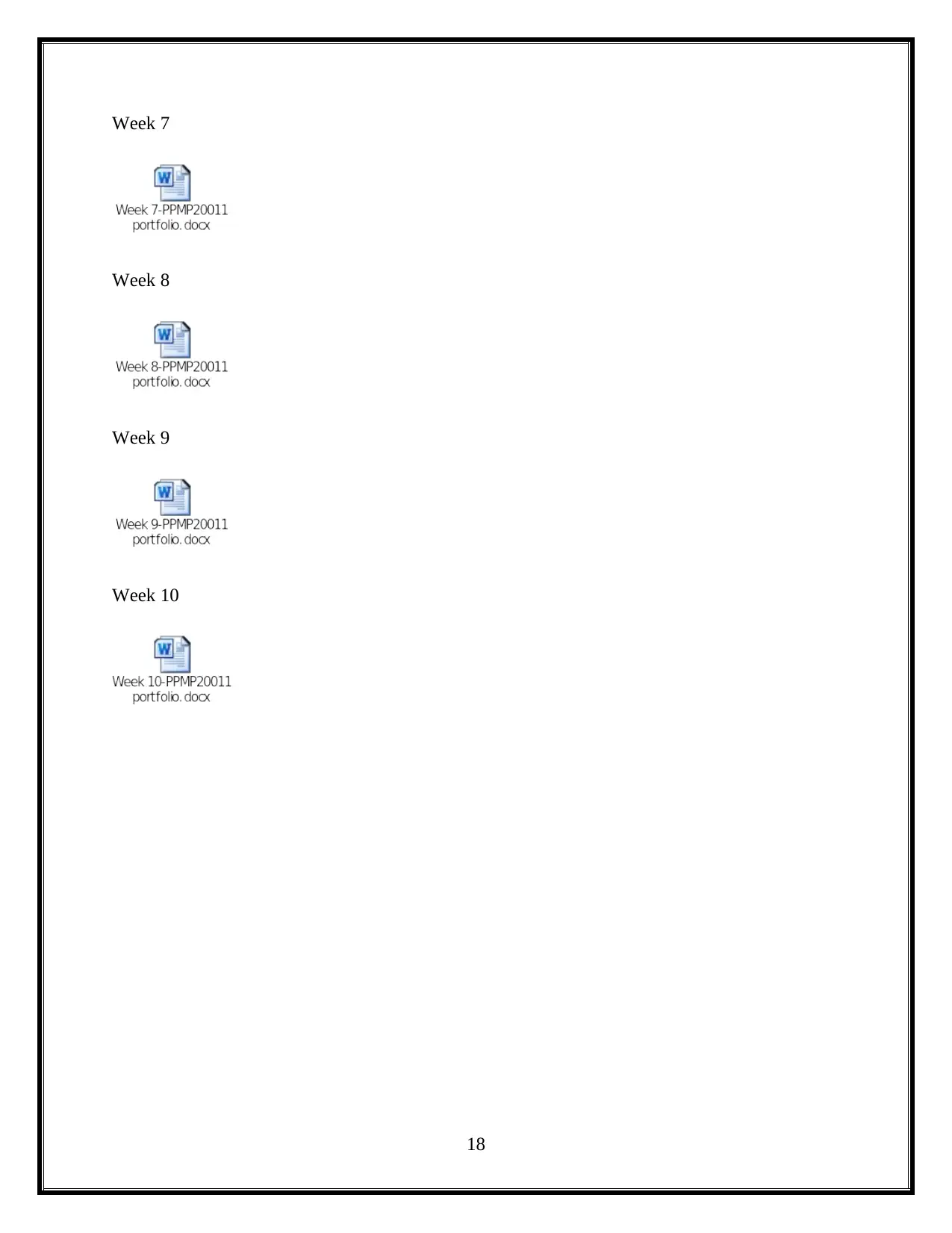
Week 7
Week 8
Week 9
Week 10
18
Week 8
Week 9
Week 10
18
1 out of 18
Related Documents
Your All-in-One AI-Powered Toolkit for Academic Success.
+13062052269
info@desklib.com
Available 24*7 on WhatsApp / Email
![[object Object]](/_next/static/media/star-bottom.7253800d.svg)
Unlock your academic potential
© 2024 | Zucol Services PVT LTD | All rights reserved.


